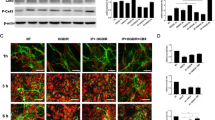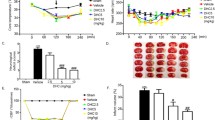Abstract
Accumulating evidence has suggested that the gap junction plays an important role in the determination of cerebral ischemia, but the underlying mechanisms remain to be elucidated. In this study, we assessed the effect of a gap-junction blocker, carbenoxolone (CBX), on ischemia/reperfusion-induced brain injury and the possible mechanisms. By using the transient cerebral ischemia model induced by occlusion of the middle cerebral artery for 30 min followed by reperfusion for 24 h, we found that pre-administration of CBX (25 mg/kg, intracerebroventricular injection, 30 min before cerebral ischemic surgery) diminished the infarction size in rats. And this was associated with a decrease of reactive oxygen species generation and inhibition of the activation of astrocytes and microglia. In PC12 cells, H2O2 treatment induced more coupling and apoptosis, while CBX partly inhibited the opening of gap junctions and improved the cell viability. These results suggest that cerebral ischemia enhances the opening of gap junctions. Blocking the gap junction with CBX may attenuate the brain injury after cerebral ischemia/reperfusion by partially contributing to amelioration of the oxidative stress and apoptosis.
Similar content being viewed by others
References
Simon AM, Goodenough DA. Diverse functions of vertebrate gap junctions. Trends Cell Biol 1998, 8: 477–483.
Bennett MV. Electrical synapses, a personal perspective (or history). Brain Res Brain Res Rev 2000, 32: 16–28.
Bissiere S, Zelikowsky M, Ponnusamy R, Jacobs NS, Blair HT, Fanselow MS. Electrical synapses control hippocampal contributions to fear learning and memory. Science 2011, 331: 87–91.
Giaume C, Koulakoff A, Roux L, Holcman D, Rouach N. Astroglial networks: a step further in neuroglial and gliovascular interactions. Nat Rev Neurosci 2010, 11: 87–99.
Retamal MA, Cortes CJ, Reuss L, Bennett MV, Saez JC. Snitrosylation and permeation through connexin 43 hemichannels in astrocytes: induction by oxidant stress and reversal by reducing agents. Proc Natl Acad Sci U S A 2006, 103: 4475–4480.
Ye ZC, Oberheim N, Kettenmann H, Ransom BR. Pharmacological “cross-inhibition” of connexin hemichannels and swelling activated anion channels. Glia 2009, 57: 258–269.
Thompson RJ, Zhou N, MacVicar BA. Ischemia opens neuronal gap junction hemichannels. Science 2006, 312: 924–927.
Cotrina ML, Kang J, Lin JH, Bueno E, Hansen TW, He L, et al. Astrocytic gap junctions remain open during ischemic conditions. J Neurosci 1998, 18: 2520–2537.
Lin JH, Yang J, Liu S, Takano T, Wang X, Gao Q, et al. Connexin mediates gap junction-independent resistance to cellular injury. J Neurosci 2003, 23: 430–441.
Rawanduzy A, Hansen A, Hansen TW, Nedergaard M. Effective reduction of infarct volume by gap junction blockade in a rodent model of stroke. J Neurosurg 1997, 87: 916–920.
Saito R, Graf R, Hubel K, Fujita T, Rosner G, Heiss WD. Reduction of infarct volume by halothane: effect on cerebral blood flow or perifocal spreading depression-like depolarizations. J Cereb Blood Flow Metab 1997, 17: 857–864.
Rami A, Volkmann T, Winckler J. Effective reduction of neuronal death by inhibiting gap junctional intercellular communication in a rodent model of global transient cerebral ischemia. Exp Neurol 2001, 170: 297–304.
Pocock G, Richards CD. Excitatory and inhibitory synaptic mechanisms in anaesthesia. Br J Anaesth 1993, 71: 134–147.
Rorig B, Klausa G, Sutor B. Intracellular acidification reduced gap junction coupling between immature rat neocortical pyramidal neurones. J Physiol 1996, 490(Pt 1): 31–49.
Davidson JS, Baumgarten IM. Glycyrrhetinic acid derivatives: a novel class of inhibitors of gap-junctional intercellular communication. Structure-activity relationships. J Pharmacol Exp Ther 1988, 246: 1104–1107.
Frantseva MV, Kokarovtseva L, Naus CG, Carlen PL, MacFabe D, Perez Velazquez JL. Specific gap junctions enhance the neuronal vulnerability to brain traumatic injury. J Neurosci 2002, 22: 644–653.
Gajda Z, Gyengesi E, Hermesz E, Ali KS, Szente M. Involvement of gap junctions in the manifestation and control of the duration of seizures in rats in vivo. Epilepsia 2003, 44: 1596–1600.
Ross FM, Gwyn P, Spanswick D, Davies SN. Carbenoxolone depresses spontaneous epileptiform activity in the CA1 region of rat hippocampal slices. Neuroscience 2000, 100: 789–796.
Szente M, Gajda Z, Said Ali K, Hermesz E. Involvement of electrical coupling in the in vivo ictal epileptiform activity induced by 4-aminopyridine in the neocortex. Neuroscience 2002, 115: 1067–1078.
Frantseva MV, Kokarovtseva L, Perez Velazquez JL. Ischemia-induced brain damage depends on specific gapjunctional coupling. J Cereb Blood Flow Metab 2002, 22: 453–462.
Schmitz D, Schuchmann S, Fisahn A, Draguhn A, Buhl EH, Petrasch-Parwez E, et al. Axo-axonal coupling. a novel mechanism for ultrafast neuronal communication. Neuron 2001, 31: 831–840.
Jellinck PH, Monder C, McEwen BS, Sakai RR. Differential inhibition of 11 beta-hydroxysteroid dehydrogenase by carbenoxolone in rat brain regions and peripheral tissues. J Steroid Biochem Mol Biol 1993, 46: 209–213.
Bani-Yaghoub M, Underhill TM, Naus CC. Gap junction blockage interferes with neuronal and astroglial differentiation of mouse P19 embryonal carcinoma cells. Dev Genet 1999, 24: 69–81.
Vakili A, Hosseinzadeh SA, Khorasani MZ. Peripheral administration of carbenoxolone reduces ischemic reperfusion injury in transient model of cerebral ischemia. J Stroke Cerebrovasc Dis 2009, 18: 81–85.
Khorasani MZ, Hosseinzadeh SA, Vakili A. Effect of central microinjection of carbenoxolone in an experimental model of focal cerebral ischemia. Pak J Pharm Sci 2009, 22: 349–354.
Perez Velazquez JL, Kokarovtseva L, Sarbaziha R, Jeyapalan Z, Leshchenko Y. Role of gap junctional coupling in astrocytic networks in the determination of global ischaemiainduced oxidative stress and hippocampal damage. Eur J Neurosci 2006, 23: 1–10.
Xie M, Yi C, Luo X, Xu S, Yu Z, Tang Y, et al. Glial gap junctional communication involvement in hippocampal damage after middle cerebral artery occlusion. Ann Neurol 2011, 70: 121–132.
Tamura K, Alessandri B, Heimann A, Kempski O. The effect of a gap-junction blocker, carbenoxolone, on ischemic brain injury and cortical spreading depression. Neuroscience 2011, 194: 262–271.
Leshchenko Y, Likhodii S, Yue W, Burnham WM, Perez Velazquez JL. Carbenoxolone does not cross the blood brain barrier: an HPLC study. BMC Neurosci 2006, 7: 3.
Zhang Y. Determination of furazolidone, carbenoxolone sodium and berberine hydrochloride in wei kang tablets by reversed-phase high performance liquid chromatography(RPHPLC). Se Pu 2002, 20: 350–352.
Vakili A, Hosseinzadeh F, Sadogh T. Effect of aminoguanidine on post-ischemic brain edema in transient model of focal cerebral ischemia. Brain Res 2007, 1170: 97–102.
el-Fouly MH, Trosko JE, Chang CC. Scrape-loading and dye transfer. A rapid and simple technique to study gap junctional intercellular communication. Exp Cell Res 1987, 168: 422–430.
Nagy JI, Hossain MZ, Hertzberg EL, Marotta CA. Induction of connexin43 and gap junctional communication in PC12 cells overexpressing the carboxy terminal region of amyloid precursor protein. J Neurosci Res 1996, 44: 124–132.
Farahani R, Pina-Benabou MH, Kyrozis A, Siddiq A, Barradas PC, Chiu FC, et al. Alterations in metabolism and gap junction expression may determine the role of astrocytes as “good samaritans” or executioners. Glia 2005, 50: 351–361.
Belliveau DJ, Bani-Yaghoub M, McGirr B, Naus CC, Rushlow WJ. Enhanced neurite outgrowth in PC12 cells mediated by connexin hemichannels and ATP. J Biol Chem 2006, 281: 20920–20931.
Kozoriz MG, Bechberger JF, Bechberger GR, Suen MW, Moreno AP, Maass K, et al. The connexin43 C-terminal region mediates neuroprotection during stroke. J Neuropathol Exp Neurol 2010, 69: 196–206.
Nakase T, Sohl G, Theis M, Willecke K, Naus CC. Increased apoptosis and inflammation after focal brain ischemia in mice lacking connexin43 in astrocytes. Am J Pathol 2004, 164: 2067–2075.
Zvalova D, Cordier J, Mesnil M, Junier MP, Chneiweiss H. p38/SAPK2 controls gap junction closure in astrocytes. Glia 2004, 46: 323–333.
Siushansian R, Bechberger JF, Cechetto DF, Hachinski VC, Naus CC. Connexin43 null mutation increases infarct size after stroke. J Comp Neurol 2001, 440: 387–394.
Nakase T, Fushiki S, Naus CC. Astrocytic gap junctions composed of connexin 43 reduce apoptotic neuronal damage in cerebral ischemia. Stroke 2003, 34: 1987–1993.
Wasielewski B, Jensen A, Roth-Harer A, Dermietzel R, Meier C. Neuroglial activation and Cx43 expression are reduced upon transplantation of human umbilical cord blood cells after perinatal hypoxic-ischemic injury. Brain Res 2012, 1487: 39–53.
Davidson JO, Green CR, Nicholson LF, O’Carroll SJ, Fraser M, Bennet L, et al. Connexin hemichannel blockade improves outcomes in a model of fetal ischemia. Ann Neurol 2012, 71: 121–132.
Hugyecz M, Mracsko E, Hertelendy P, Farkas E, Domoki F, Bari F. Hydrogen supplemented air inhalation reduces changes of prooxidant enzyme and gap junction protein levels after transient global cerebral ischemia in the rat hippocampus. Brain Res 2011, 1404: 31–38.
Nakase T, Maeda T, Yoshida Y, Nagata K. Ischemia alters the expression of connexins in the aged human brain. J Biomed Biotechnol 2009, 2009: 147946.
Nakase T, Yoshida Y, Nagata K. Enhanced connexin 43 immunoreactivity in penumbral areas in the human brain following ischemia. Glia 2006, 54: 369–375.
Nodin C, Nilsson M, Blomstrand F. Gap junction blockage limits intercellular spreading of astrocytic apoptosis induced by metabolic depression. J Neurochem 2005, 94: 1111–1123.
Tanaka M, Yamaguchi K, Tatsukawa T, Nishioka C, Nishiyama H, Theis M, et al. Lack of Connexin43-mediated bergmann glial gap junctional coupling does not affect cerebellar long-term depression, motor coordination, or eyeblink conditioning. Front Behav Neurosci 2008, 2: 1.
Amantea D, Nappi G, Bernardi G, Bagetta G, Corasaniti MT. Post-ischemic brain damage: pathophysiology and role of inflammatory mediators. FEBS J 2009, 276: 13–26.
Takano T, Oberheim N, Cotrina ML, Nedergaard M. Astrocytes and ischemic injury. Stroke 2009, 40: S8–12.
Turner DA, Adamson DC. Neuronal-astrocyte metabolic interactions: understanding the transition into abnormal astrocytoma metabolism. J Neuropathol Exp Neurol 2011, 70: 167–176.
Garg S, Md Syed M, Kielian T. Staphylococcus aureus-derived peptidoglycan induces Cx43 expression and functional gap junction intercellular communication in microglia. J Neurochem 2005, 95: 475–483.
Retamal MA, Froger N, Palacios-Prado N, Ezan P, Saez PJ, Saez JC, et al. Cx43 hemichannels and gap junction channels in astrocytes are regulated oppositely by proinflammatory cytokines released from activated microglia. J Neurosci 2007, 27: 13781–13792.
Takeuchi H, Jin S, Wang J, Zhang G, Kawanokuchi J, Kuno R, et al. Tumor necrosis factor-alpha induces neurotoxicity via glutamate release from hemichannels of activated microglia in an autocrine manner. J Biol Chem 2006, 281: 21362–21368.
Udawatte C, Ripps H. The spread of apoptosis through gapjunctional channels in BHK cells transfected with Cx32. Apoptosis 2005, 10: 1019–1029.
de Pina-Benabou MH, Szostak V, Kyrozis A, Rempe D, Uziel D, Urban-Maldonado M, et al. Blockade of gap junctions in vivo provides neuroprotection after perinatal global ischemia. Stroke 2005, 36: 2232–2237.
Author information
Authors and Affiliations
Corresponding author
Additional information
These authors contributed equally to this work.
Rights and permissions
About this article
Cite this article
Zhang, L., Li, YM., Jing, YH. et al. Protective effects of carbenoxolone are associated with attenuation of oxidative stress in ischemic brain injury. Neurosci. Bull. 29, 311–320 (2013). https://doi.org/10.1007/s12264-013-1342-y
Received:
Accepted:
Published:
Issue Date:
DOI: https://doi.org/10.1007/s12264-013-1342-y




